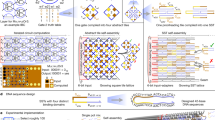Abstract
Self-assembly is a phenomenon observed in nature at all scales where autonomous entities build complex structures, without external influences nor centralised master plan. Modelling such entities and programming correct interactions among them is crucial for controlling the manufacture of desired complex structures at the molecular and supramolecular scale. This work focuses on a programmability model for non DNA-based molecules and complex behaviour analysis of their self-assembled conformations. In particular, we look into modelling, programming and simulation of porphyrin molecules self-assembly and apply Kolgomorov complexity-based techniques to classify and assess simulation results in terms of information content. The analysis focuses on phase transition, clustering, variability and parameter discovery which as a whole pave the way to the notion of complex systems programmability.



















Similar content being viewed by others
Notes
Available at http://pmt.sourceforge.net/pngcrush/ (accessed on October 14, 2012) set to maximum compression.
References
Adleman LM, Cheng Q, Goel A, Huang MD (2001) Running time and program size for self-assembled squares. In: Symposium on theory of computing, ACM, pp 740–748
Adleman LM, Cheng Q, Goel A, Huang MD, Kempe D, Moisset de Espanés P, Rothemund PWK (2002) Combinatorial optimization problems in self-assembly. In: Symposium on theory of computing, ACM, pp 23–32
Anderberg MR (1973) Cluster analysis for applications. Academic Press, New York
Bruschi P, Cagnoni P, Nannini A (1997) Temperature-dependent Monte Carlo simulations of thin metal film growth and percolation. Phys Rev B: Condens Matter 55(12):7955–7963
Chaitin GJ (1969) On the length of programs for computing finite binary sequences: statistical considerations. J ACM 1:145–159
Cheng Q, Goel A, Moisset de Espanés P (2004) Optimal self-assembly of counters at temperature two. In: Foundations of Nanoscience: self-assembled architectures and devices
Cilibrasi R, Vitányi PMB (2005) Clustering by compression. IEEE Trans Inf Theory 51(4):1523–1545
Dubacq JC, Durand B, Formenti E (2001) Kolmogorov complexity and cellular automata classification. Theoret Comput Sci 1–2:271–285
Moisset de Espanés P (2008) Computer aided search for optimal self-assembly systems. In: Krasnogor et al. (ed) pp 225–243
Ferragina P, Giancarlo R, Greco V, Manzini G, Valiente G (2007) Compression-based classification of biological sequences and structures via the universal similarity metric: experimental assessment. BMC Bioinform 8(1):252
Flenner E, Janosi L, Barz B, Neagu A, Forgacs G, Kosztin I (2012) Kinetic Monte Carlo and cellular particle dynamics simulations of multicellular systems. Phys Rev E 85(3):031907–031916
Goldin D, Wegner P (2006) Interactive computation. In: Goldin D, Smolka S, Wegner P (eds) Principles of interactive computation, Springer, Berlin, p 25–37
Keogh E, Lonardi S, Ratanamahatana CA, Wei L, Lee SH, Handley J (2007) Compression-based data mining of sequential data. Data Min Knowl Disc 14(1):99–129
Kolmogorov AN (1965) Three approaches to the quantitative definition of information. Probl Inf Transm 1:1–7
Krasnogor N, Gustafson S, Pelta DA, Verdegay JL (2008) Systems self-assembly: multidisciplinary snapshots, studies in multidisciplinarity, vol 5. Elsevier, Amsterdam
Li M, Chen X, Li X, Ma B, Vitányi PMB (2004) The similarity metric. IEEE Trans Inf Theory 50(12):3250–3264
Mao C, LaBean T, Reif JH (2000) Logical computation using algorithmic self-assembly of DNA triple crossover molecules. Nature 407:493–496
Mealy GH (1955) A method for synthesizing sequential circuits. Bell Syst Tech J 34(5):1045–1079
Pelesko JA (2007) Self assembly: the science of things that put themselves together. Chapman & Hall/CRC, London
Rothemund PWK (2000) Using lateral capillary forces to compute by self-assembly. Proc Natl Acad Sci USA 97(3):984–989
Rothemund PWK, Winfree E (2000) The program-size complexity of self-assembled squares. In: Symposium on theory of computing, ACM, pp 459–468
Siepmann P, Terrazas G, Krasnogor N (2006) Evolutionary design for the behaviour of cellular automaton-based complex systems. In: Adaptive computing in design and manufacture, pp 199–208
Siepmann P, Martin CP, Vancea I, Moriarty PJ, Krasnogor N (2007) A genetic algorithm approach to probing the evolution of self-organised nanostructured systems. Nano Lett 7:1985–1990
Soloveichik D, Winfree E (2005) The computational power of Benenson automata. Theoret Comput Sci 344(2–3):279–297
Terrazas G, Krasnogor N, Kendall G, Gheorghe M (2005) Automated tile design for self-assembly conformations. In: IEEE congress on evolutionary computation, vol 2. IEEE Press, Los Alamitos, p 1808–1814
Terrazas G, Gheorghe M, Kendall G, Krasnogor N (2007a) Evolving tiles for automated self-assembly design. In: IEEE congress on evolutionary computation, IEEE Press, Los Alamitos, p 2001–2008
Terrazas G, Siepmann P, Kendall G, Krasnogor N (2007b) An evolutionary methodology for the automated design of cellular automaton-based complex systems. J Cell Autom 2(1):77–102
Terrazas G, Lui LT, Krasnogor N (2013) Spatial computation and algorithmic information content in non-DNA based molecular self-assembly. In: Spatial computing, p 85–90
Vitányi PMB (2011) Information distance in multiples. IEEE Trans Inf Theory 57(4):2451–2456
Vitányi PMB (2012) Information distance: new developments. In: Information theoretic methods in science and engineering, p 71–74
Wang H (1961) Proving theorems by pattern recognition. Bell Syst Tech J 40:1–42
Winfree E (1996) On the computational power of DNA annealing and ligation. In: Discrete mathematics and theoretical computer science, vol 27. American Mathematical Society, Providence, p 199–221
Winfree E, Bekbolatov R (2003) Proofreading tile sets: error correction for algorithmic self-assembly. DNA Comput 2943:126–144
Winfree E, Liu F, Wenzler LA, Seeman NC (1998) Design and self-assembly of two-dimensional DNA crystals. Nature 394:539–544
Woolley RAJ, Stirling J, Radocea A, Krasnogor N, Moriarty P (2011) Automated probe microscopy via evolutionary optimization at the atomic scale. Appl Phys Lett 98(25):253,104–253,104
Zenil H (2010) Compression-based investigation of the dynamical properties of cellular automata and other systems. Complex Syst 19(1):1–28
Zenil H (2012) On the dynamic qualitative behavior of universal computation. Complex Syst 20(3):265–278
Acknowledgments
This work is supported by EPSRC grants EPSRC EP/J004111/1 and EP/H010432/1 Evolutionary Optimisation of Self-Assembly Nano-Design (ExIStENcE). The authors acknowledge the insightful discussions on the chemistry and physics of porphyrins with Prof. N. Champness, Prof. A. Moriarty and Prof. P. Beton from the University of Nottingham.
Author information
Authors and Affiliations
Corresponding author
Rights and permissions
About this article
Cite this article
Terrazas, G., Zenil, H. & Krasnogor, N. Exploring programmable self-assembly in non-DNA based molecular computing. Nat Comput 12, 499–515 (2013). https://doi.org/10.1007/s11047-013-9397-2
Published:
Issue Date:
DOI: https://doi.org/10.1007/s11047-013-9397-2




